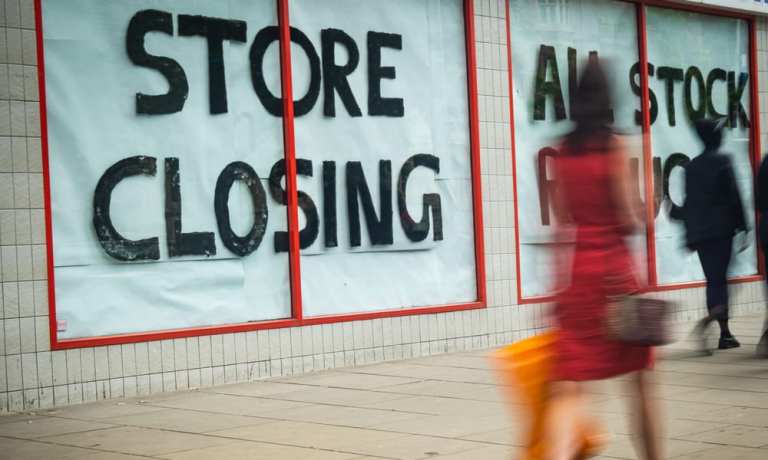As retail reopens and starts to spur some optimism for the future, a dark number appeared on the scene on Tuesday (June 10). Coresight released a report that says 25,000 retail storefronts will close by the end of the year. Coresight’s research is not in question here, nor is its motive or intention in preparing their clients for such an eventuality. But the numbers show that the retail apocalypse – whether driven by the pandemic or not – could become a retail Armageddon. Alternative research and other market dynamics make such a scenario seem unlikely.
There are many reasons that the number seems overly aggressive. Three of them are the most compelling: sheer numbers, market conditions and consumer sentiment.
First, the numbers. Coresight has already counted out about 4,000 retail storefronts so far this year, either from the pandemic or other economic causes. That includes 900 Pier 1 locations and some other more minor liquidations. That means that between June 1, 2020 and January 1, 2021, 21,000 more stores will shutter.
Last year, which was the worst of what used to be called the retail apocalypse, saw about 9,000 brick-and-mortar storefronts close. If the pandemic morphs into a strong second surge and leads to another lockdown, this kind of complete collapse could be feasible. But from today’s standpoint, it’s tough to see how 21,000 more stores could close.
On a percentage basis, it doesn’t look like much. The NRF says there are a million brick-and-mortar storefronts in the U.S. (counting restaurants), and other sources say the number is as low as 445,000. But the bloodletting that could stalk retail is not about percentages – it’s about market conditions and the companies that control major retailers.
In terms of those companies, it’s doubtful that the big at-risk chains like Neiman Marcus, Macy’s or Nordstrom will go down without a fight. After all, they have access to capital, and they have shown strong balance sheets in the past. They’re optimistic about reopening.
Advertisement: Scroll to Continue
Which brings us to market conditions. The first is the pandemic-driven digital shift. PYMNTS research shows that 42.2 percent of U.S. consumers have gone online to shop since the pandemic started. However, this shift does not portend a complete abandonment of brick-and-mortar retail. There are solid reasons consumers are going online, most having to do with health and safety. But retailers are picking up on those reasons and incorporating them into their business models. That’s likely why in PYMNTS’ national study of 14,000 consumers, more than half (58.6 percent) said they expect merchants to offer a way to pay in-store without interacting with a card reader, something they say is 59.7 percent more important than providing a contactless card option at a terminal.
Here’s a reinforcing example: According to Cambridge Retail Advisors, 56 percent of C-level executives feel the pandemic will permanently change the way people shop, and that most consumers will move exclusively to BOPIS (buy online, pick up in-store) or BOPAC (buy online, pick up at curb) shopping, processes that begin online and end at the store.
And another one, from a new Deloitte report: “During the first months of the COVID-19 crisis, there has been an acceleration of digital retail: Those retailers with strong platforms and sophisticated data analysis have succeeded in connecting with consumers and offering them additional services and value. Consumers are willing to embrace and explore new digital experiences due to public health concerns –telemedicine, online learning, virtual payments and online grocery ordering and delivery. As the convenience of these experiences increases, we expect these trends to accelerate. Before COVID-19, the convenience trend was being rewritten by players outside of the industry, putting pressure on retailers to reshape consumer expectations. As the crisis hit, retailers had to rapidly roll out offerings such as BOPIS, curbside pickup and delivery.”
These are just some of the major adjustments that are part of a new hybrid model of retailing. Again, it’s a new model, not a collapse. If brick-and-mortar retail spend drops 10 percent this year, as eMarketer is now predicting, that’s not enough to drive a 25,000-store hit. And who knows? Maybe a more limited offline retail shutdown will make real estate more attractive to the Rent the Runways and Amazons of the world. New hybrid retail models could emerge.
Third, there’s no preponderance of evidence at this point that says consumers won’t return to brick-and-mortar retail. Look at the throngs of people that recently gathered at TJ Maxx and Ross Dress For Less. And even Macy’s, which has had to contend with store damage from recent unrest in New York City, has expressed optimism. “We are seeing strong sell-through of seasonal merchandise, and anticipate that we will exit the second quarter in a clean inventory position,” said Macy’s CEP Jeff Gennette in a statement. He noted that the holiday season will be crucial.
That could turn out to be quite an understatement.




